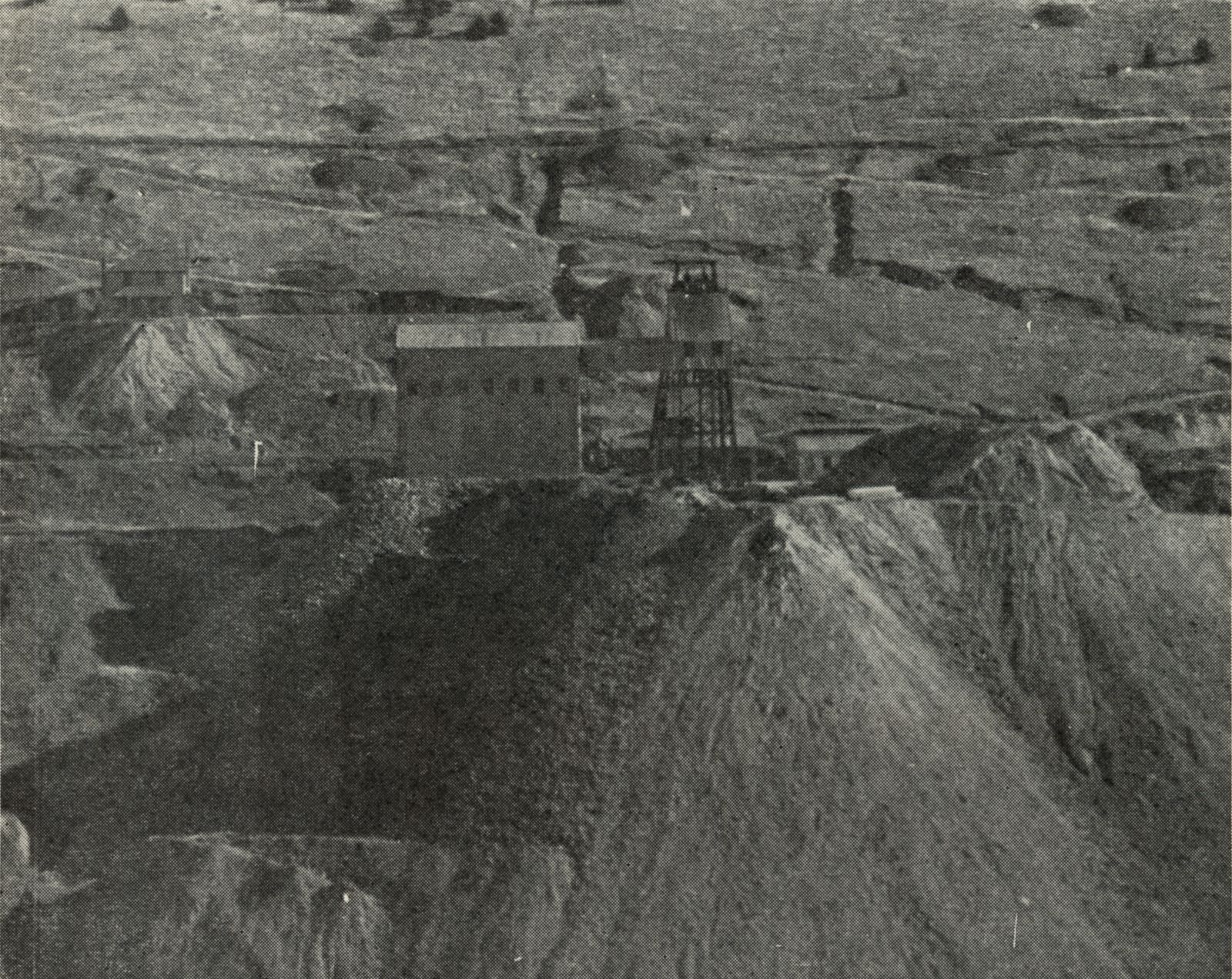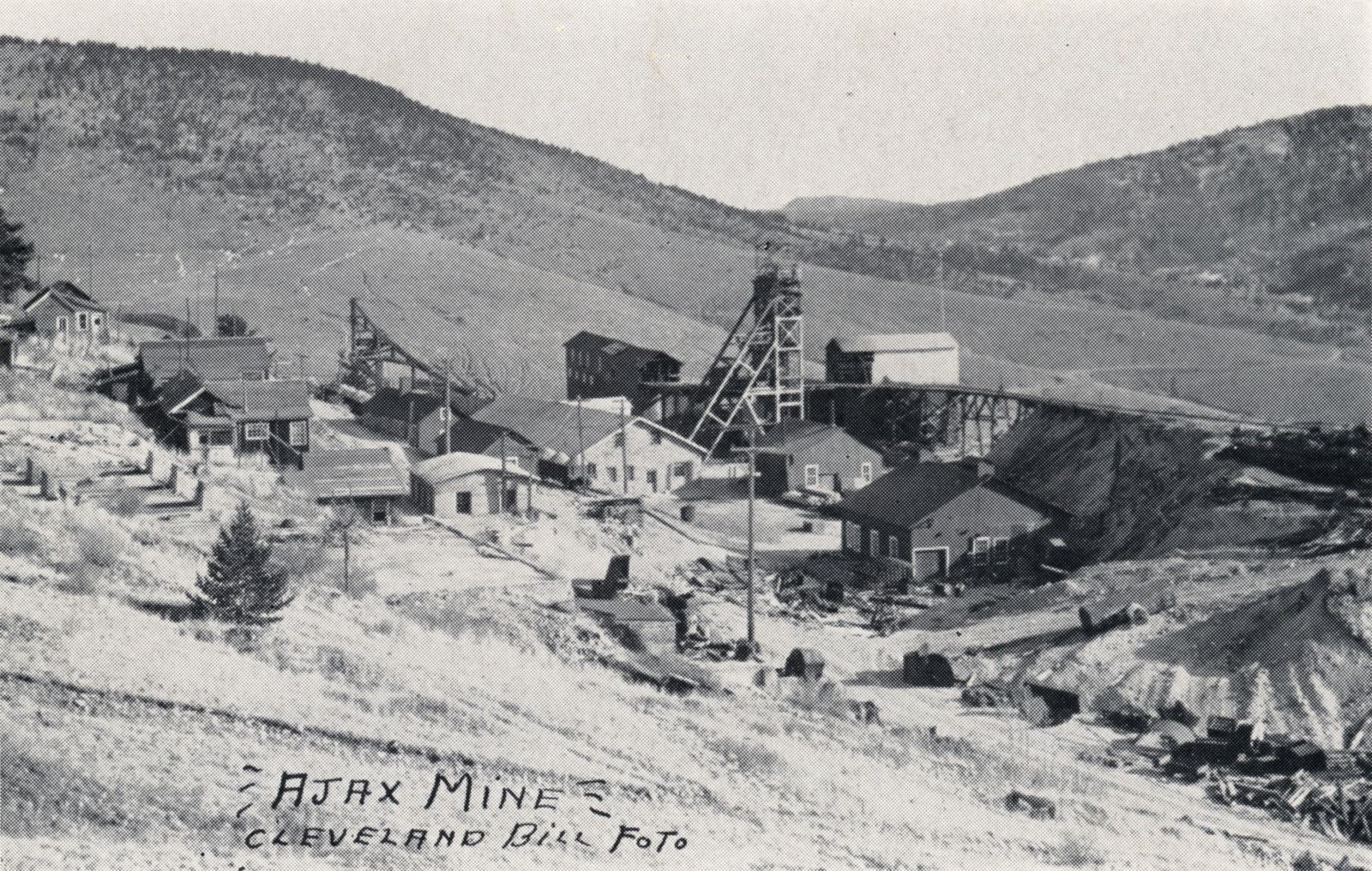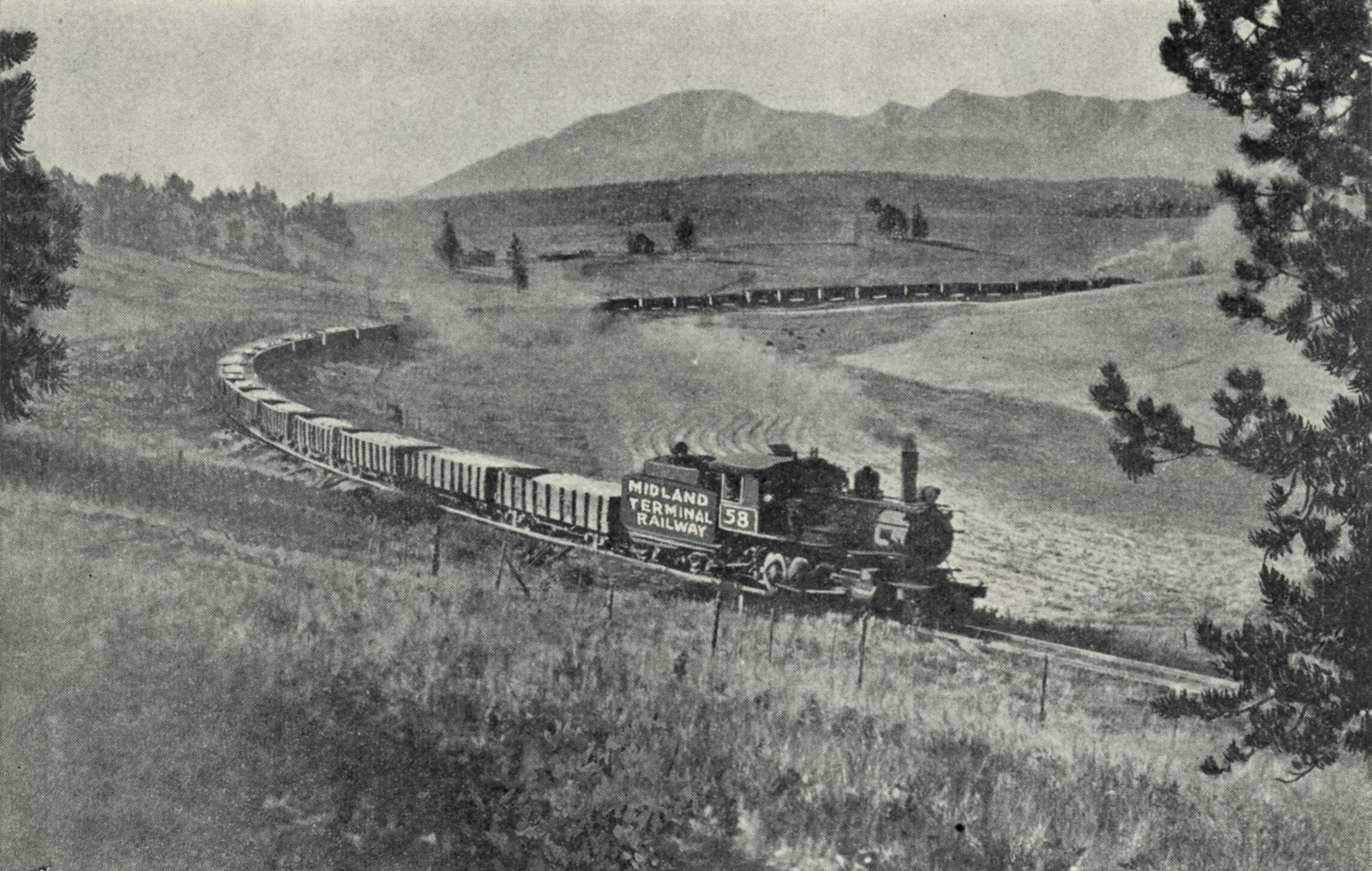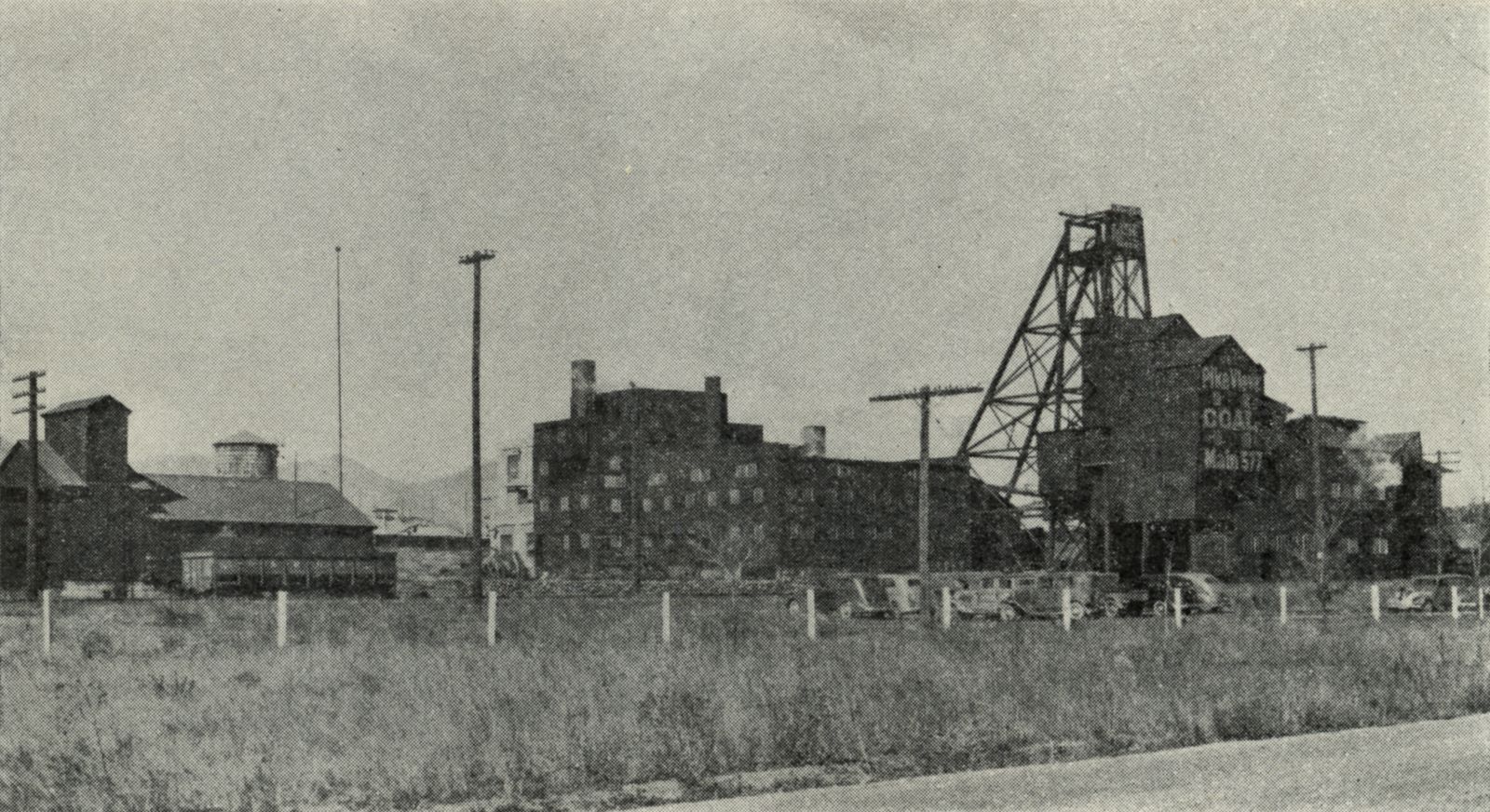-> My Collection; The whole Report can be seen here as an Image Only Album.
(18 pages with text + 10 more with images)
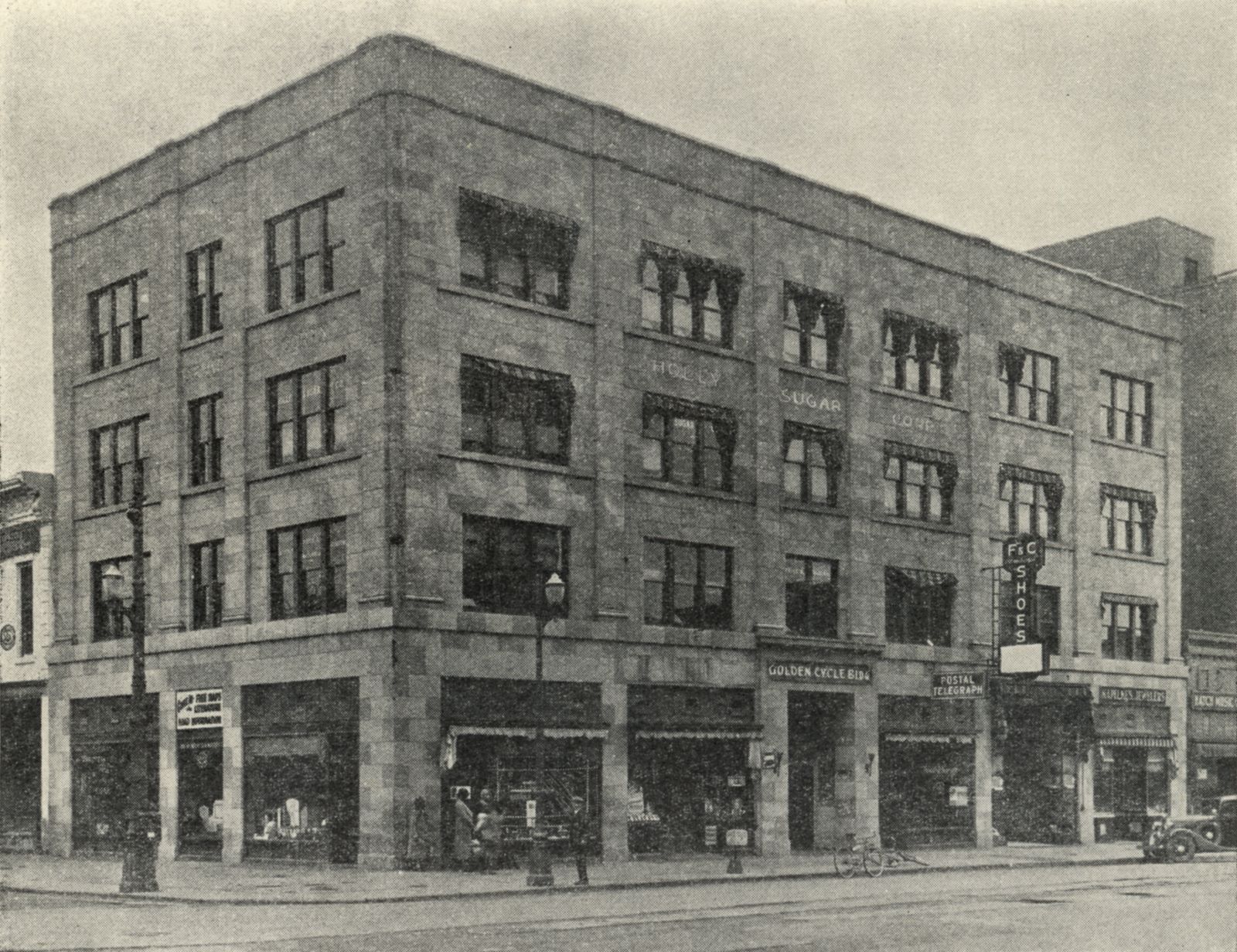
GOLDEN CYCLE BUILDING, Colorado Springs. Owned by the Golden Cycle Corporation. Retail office of the Pikes Peak Fuel Division located in this building.
- MERRILL E. SHOUP
- E. I. CARLTON
- J. S. TUCKER
- W. P. TANNER
- MAX W. BOWEN
- A. H. BEBEE
- Wm. I. HOWBERT
- MERRILL E. SHOUP, President
- W. P. TANNER, Vice President
- MAX W. BOWEN, in Charge of Milling Operations, Vice President
- A. H. BEBEE, in Charge of Mining Operations, Vice President
- Wm. I. HOWBERT, Treasurer
- H. BATES, Secretary
Colorado Springs, Colorado,
March 10, 1942.
To the Stockholders of
THE GOLDEN CYCLE CORPORATION:
Herewith is annual report of The Golden Cycle Corporation and its wholly owned subsidiaries for the year ended December 31, 1941.
|
NET INCOME
The consolidated operating results for 1941 and 1940, before and after provisional charges and income taxes, are compared as follows: |
|||
| 1941 | 1940 | Increase (Decrease) |
|
| Net income before provisional charges and income taxes | $ 945,756.92 | $ 905,010.18 | $ 40,746.74 |
| Deduct: | |||
Provisional charges: |
|||
Amortization of cost of Carlton Tunnel (ten months ended December 31, 1941) |
$ 101,034.43 | $ 101,034.43 | |
Depreciation |
102,259.40 | $ 87,451.77 | 14,807.63 |
Depletion |
23,118.44 | 20,918.55 | 2,199.89 |
Total provisional charges |
$ 226,412.27 | $ 108,370.32 | $ 118,041.95 |
Federal and Colorado income taxes |
250,000.00 | 212,000.00 | 38,000.00 |
Total deductions |
$ 476,412.27 | $ 320,370.32 | $ 156,041.95 |
Ratio |
50.4% | 35.4% | 15.0% |
| Net income | $ 469,344.65 | $ 584,639.86 | ($ 115,295.21) |
| Amount per share | $ 2.51 | $ 3.13 | ($ 0.62) |
It will be noted that the 1941 net income before provisional charges and income taxes was slightly more than for 1940. The decrease of $115,295.21 in net income reflects largely the increased provisional charges which were more than twice those for 1940 because of the provision of $101,034.43 for amortization of cost of the Carlton Drainage Tunnel. This provision, which has been made in accordance with conservative accounting and financial practice, has been reported as a deduction for income tax purposes.
Significant factors affecting 1941 operations were:
- Decreased tonnage shipped to the mill, both from Cripple Creek and other mining districts of Colorado.
- Adverse economic factors affecting the gold mining industry, chief of which are:
- Loss of lessees and company employees leaving for the army and navy, both by enlistment and the Selective Service Act.
- Loss of company employees and lessees leaving mining districts to work in defense and war industries. Gold mining and its allied activities cannot compete with the excessively high wages paid by these industries. At least 500 men left the Cripple Creek Mining District alone during the latter part of 1941. This exodus is continuing this year, and is creating a severe labor shortage.
- Increased costs of labor and of mining and milling supplies.
- Government priority restrictions on machinery, repairs and replacement parts, rubber and other essentials. These have become progressively severe and will become more so as our war effort expands.
- Terrific increases in taxes of all kinds.
The increased cost of labor, machinery, equipment and priority restrictions, a decreased production of ore due to the factors above set out, coupled with the fact that the price of gold remains fixed, are economic factors over which the management has no control. With a fixed price for gold, increased production costs must be absorbed by the ore producer and refiner and cannot be passed on to the ultimate consumer.
The adverse factors set out above are certain to affect gold mining and milling to an increasing degree during 1942 and until war with the Axis is ended.
Less tonnage can be anticipated for the mill to treat since less ore will be produced and shipped to us. Per ton milling costs decline as tonnage increases and increase as tonnage decreases. Higher costs from increased wages, mining and milling supplies must prevail.
Government restrictions and priorities are becoming increasingly severe. Industries not contributing directly to the war effort will be curtailed, and gold mining will suffer as it did during World War I.
On March 2, 1942, the Administrator of the Mining Branch of War Production Board revised Orders P-56 and P-S6-A, withdrawing from all gold and silver mines their priorities for the purchase of essential mining and milling materials, basing his action upon the ground that steel and other metal products used by gold and silver mines are required for the mining and milling of essential strategic minerals. The order in general excludes all mines from preferred priority rights in which the combined gold-silver account amounts to more than thirty per cent of the dollar value of the product. The chief ore production from Cripple Creek is gold, and this order as now constituted eliminates our properties from preferred priority ratings.
Unless modified so gold and silver mines can get relief and can continue to secure necessary mining essentials then, until the war is over, or until there is a surplus of essential metals required for mining and milling above the needs for war products, the immediate future of gold mining is none too bright. If not withdrawn or modified, this order could ultimately seriously cripple or close down more than 1,000 mines in Colorado alone and will be detrimental to all western mining states. The mining industry of these western states is making every effort to get relief. Whether or not it will succeed is at this time unknown.
The 1939 and 1940 annual reports contained a detailed list of the properties and subsidiaries operated by The Golden Cycle Corporation. Operations of our properties during 1941 are briefly described hereinafter.
Stockholders' attention is called to the provision of $101,034.43 for tunnel amortization based on a total cost of $1,081,289.72 at December 31, 1941. The cost of the Carlton Drainage Tunnel will be amortized over a period of years; the annual amount being based upon the Cripple Creek tonnage handled each year by the Golden Cycle Mill. Amortization will be continued until the total cost has been written off.
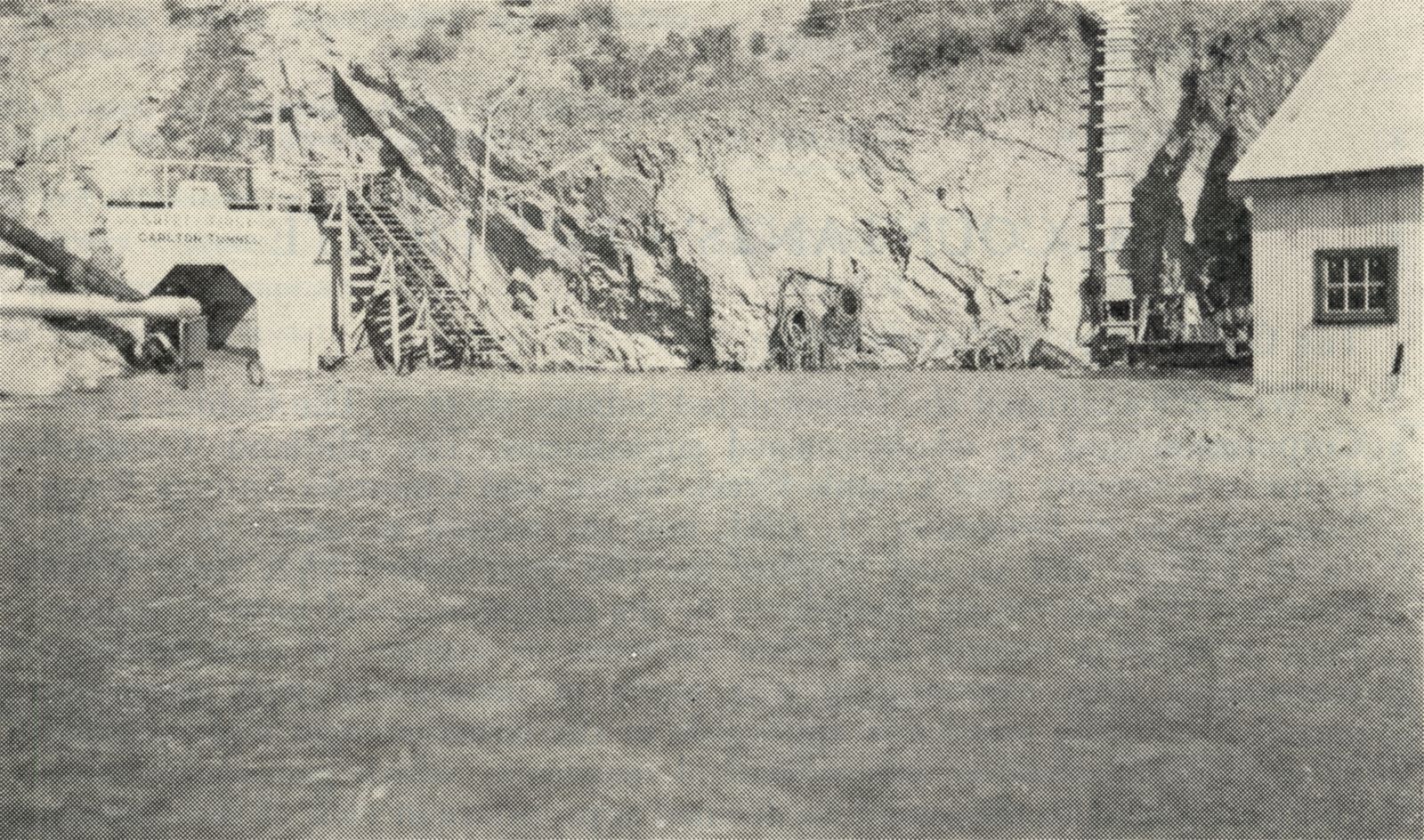
WATER GUSHED From the portal of the new Carlton Drainage Tunnel as the underground lake which had flooded the lower levels of the Portland Mine was reached. Flow at time this picture was taken about 125,000 gallons of water per minute.
Mr. Bebee's report covering the Carlton Drainage Tunnel appears later herein. Drainage became effective the latter part of February, 1941. The tunnel was finished to the breccia granite contact under the Portland No. 2 Shaft in September, 1941. From July 18, 1939, to September 1, 1941, a total of 32,927 feet or 6.236 miles of tunnel was driven. Probably no drainage tunnel in history was ever driven with speed and precision comparable to the Carlton Drainage Tunnel. Great credit goes to Mr. Bebee for his fine planning and engineering and supervisory work on this amazing project.
We already have had benefits from the completion of the tunnel. The Ajax Shaft has been completely drained, permitting development work and mining to be carried on in territory which was formerly under water. In the latter part of 1941 some extremely good ore was shipped to the mill from the dewatered territory and shipments are continuing in 1942.
Portland No. 2 Shaft has been drained. The Cresson Shaft has drained a depth of 250 feet, so development work and mining can now be done on the 18th and 19th levels. The El Paso Mine is now sinking a winze below the Roosevelt Tunnel. The United Gold Mines Company and The Cresson Consolidated Gold Mining and Milling Company will, as soon as practical and economic conditions permit, drive laterals to unwater deeper levels of their respective properties.
At December 31, 1941, tunnel costs aggregating $1,081,289.72 had been capitalized as compared with $896,950.38 at December 31, 1940, an increase of $184,339.34.
The detailed report of Max W. Bowen, Vice President in Charge of Milling, is hereinafter set out. The highlights of 1941 are here briefly sketched. Tonnage treated and operating costs decreased, while average values and gross value increased as follows:
| 1941 | 1940 | Increase (Decrease) |
|
|---|---|---|---|
| Total tonnage treated | 532,127 | 550,521 | (18,394) |
| Average value per ton | $ 10.01 | $ 9.53 | $ 0.48 |
| Gross value | $ 5,325,038.55 | $ 5,244,822.61 | $ 80,215.94 |
| Overall operating costs per ton | $ 1.55 | $ 1.57 | ($ 0.02) |
Additional improvements were made to the Mill in 1941. We hope during 1942 to continue our betterment program, but progress which can be made will depend upon economic conditions, priority restrictions and other factors, the effect of which cannot be stated at this time.
Credit is given to Max W. Bowen, Vice President in Charge of Milling Operations, for his excellent management.
Tonnage produced by the coal mine in 1941 was 174,085 vs. 183,585 in 1940, a decrease of 9,500 tons. Average price received per ton of coal sold in 1941 was $2.90 vs. $2.56 in 1940, an increase of $ 0.34 per ton.
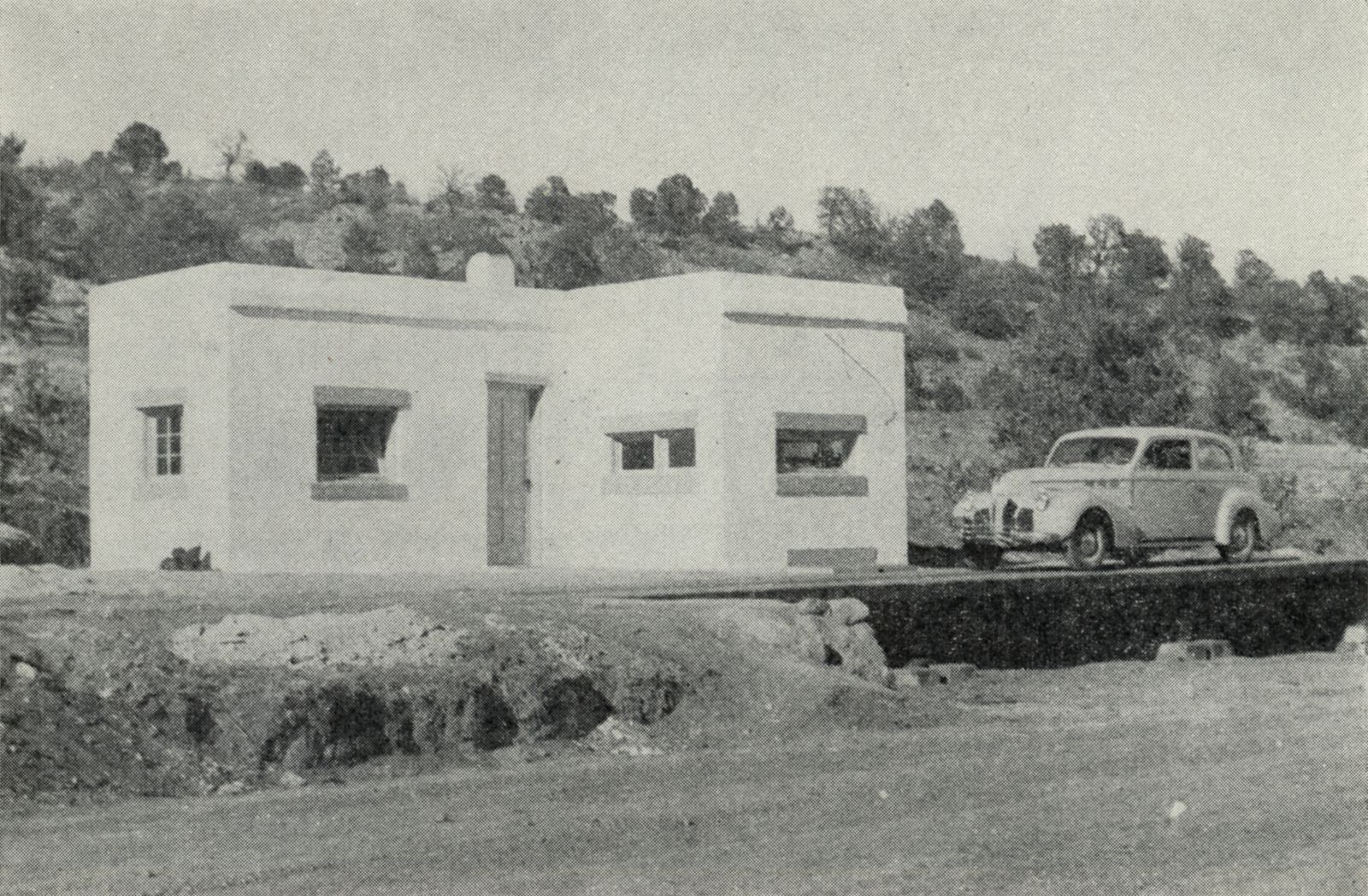
SCALE HOUSE recently completed by The Pikes Peak Fuel Division of the Golden Cycle Corporation; which operates eight bituminous coal mines in the Canon City, Colorado, field. These mines are operated by lessees.
Mechanization of the mine continued through the year and will be continued during 1942. Wages, cost of materials and overall mining costs all increased during the year, amounting to $1.75 per ton in 1941 vs. $1.63 in 1940, an increase of $ 0.12. To compensate for ever increasing costs and taxes further mechanization is absolutely necessary.
Production from our coal properties in Fremont County, Colorado, in 1941 was 28,459 tons vs. 20,432 tons in 1940. Eight sets of lessees now operate the mines on a royalty payment basis. Net income from royalty after payment of all expenses for 1941 was $5,233.61 compared to $4,735.63 in 1940, an increase of $497.98. During the year new roads were graded by our corporation to the mines and a central scale to properly weigh large truck-borne loads installed. All coal produced from this property is transported via truck to the market.
Sales of sand, gravel, building stone, riprap and miscellaneous items were fair in 1941.
The Ajax Gold Mine had a net profit in 1941 of $26,792.92 vs. a net loss in 1940 of $14,484.25. When the Carlton Drainage Tunnel cut the New Market Fault in February, 1941, the Ajax Mine drained in ten days. We are now mining in areas which have been unwatered by the tunnel. Practically all the present production from the Ajax is coming from drained areas which prior to completion of the tunnel were inaccessible or could not be profitably mined because of water problems and expense. Production for the latter part of 1941 was much greater than for the early part. In 1941 the Company and lessees shipped 29,332 tons of ore with a gross value of $437,760.05 and an average value of $14.92 per ton, compared to 22,203 tons of a gross value of $226,628.07 and an average value of $10.21 per ton in 1940.
Since the Golden Cycle Corporation acquired the Ajax Mine in August, 1935, the total gross value of ore shipped to the Golden Cycle Mill through December 31, 1941, has been $3,803,509.68, the number of tons 239,743, with an average gross value of $15.86. During this period the Ajax paid to the Midland Terminal Railroad for freight and the Golden Cycle Mill for treatment the total sum of $1,313,226.66.
Stockholders' attention is called to the report of A. H. Bebee, Vice President in Charge of Mining Operations, covering not only the Ajax but all other operations of the Golden Cycle Corporation in the Cripple Creek District. Appreciation is expressed to him for his efficient management and able supervision.
Net loss in 1941 was $4,224.71, compared to net profit in 1940 before income taxes of $18,797.75. The chief reason for the loss shown by the Anchoria Leland during 1941 is the fact that though considerable development work was done, no new ore bodies of any magnitude were uncovered. Development work will be continued during 1942 and it is hoped some new ore will be uncovered.
The Anchoria Leland, purchased in June, 1935, by the Golden Cycle Corporation, has shipped to the Cycle Mill ore of a total gross value of $576,122.52, with the number of tons for the same period 46,304, and an average per ton value of $12.44. During this period the Anchoria Leland paid to the Midland Terminal Railroad freight and the Golden Cycle Mill for treatment the total sum of $238,509.79.
Net loss of the Index for the year 1941 was $8,837.13 compared to net loss in 1940 of $22,734.20, a decrease of $13,897.07.
The Index was closed down temporarily in November, 1941, when the number of lessees working in the mine dwindled to one set. Lessees, however, are continuing shipment of dump ore to the mill.
Net profit for the year 1941 was $584.07 compared to a loss of $165.49 in the year 1940. Some better grade ore has been uncovered on the upper end of the property in the Grace Greenwood section. It is hoped considerable additional development work can be done during 1942. During 1941 the LeClair shipped to the Golden Cycle Mill 5,437 tons of ore with a gross value of $33,906.05 and an average per ton value of $6.24.
In 1941 the net income of the United Gold Mines Company was $53,966.62 compared to $47,936.66 in 1940. The Golden Cycle Corporation owns 1,263,256 shares or approximately 26 per cent of its outstanding capitalization. A dividend at the rate of one-half cent per share was paid by the United Gold Mines Company in December, 1941.
The Portland properties of the United Gold Mines Company have already been benefited by drainage from the Carlton Tunnel. At present a station is being cut preparatory to connecting Portland No. 2 Shaft with the Carlton Drainage Tunnel and development work is now in progress on the deeper levels of the Portland.
During 1941, United Gold Mines shipped to the Cycle Mill a total of 149,236 tons of ore with gross value of $1,430,199.42 and an average gross value per ton of $9.58.
Net income of the Golden Cycle Office Building for 1941 was $11,537.50, compared to $11,681.85 in 1940. The building has been properly maintained and all space is leased to good tenants and there are no vacancies at present.
Net earnings for 1941 were $56,151.20, after provision for income taxes, compared to $111,437.39 in 1940, or a decrease of $55,286.19. This decrease is due chiefly to the following:
- Laying more than 10 miles of 90-pound rail, purchased in 1940, up the Ute Pass section of the Midland Terminal Railway Company at a cost of almost $36,000.00;
- Renewals to the track by the installation of 23,619 new creosoted ties, an increase of more than 10,000 ties over 1940; and
- Expenditures incurred to repair rolling stock, buildings and the roadbed.
Due to the war, it will probably be impossible to make many improvements during 1942.
A statement of the operation of the Midland Terminal Railway Company for 1941 by A. S. Gill, Vice President, Treasurer, and Auditor, is in this report. Total ton miles of freight hauled in 1941 was 30,668,627 vs. 29,875,149 in 1940, an increase of 793,478 tons. Of this increased tonnage commercial ballast shipments, comprising a considerable tonnage but commanding a relatively low freight rate, constituted a considerable portion. Appreciation is expressed to A. S. Gill, Vice President, Treasurer, and Auditor, and W. H. McKay, General Manager, for their fine conscientious work last year.
Stockholders are assured that whether or not relief from priority and other restrictions is secured, the management will make every effort to operate the properties of the Golden Cycle Corporation, both mines and the mill, as long as possible and will use its best efforts to preserve and protect the stockholders' interests.
Respectfully submitted,
MERRILL E. SHOUP, President.
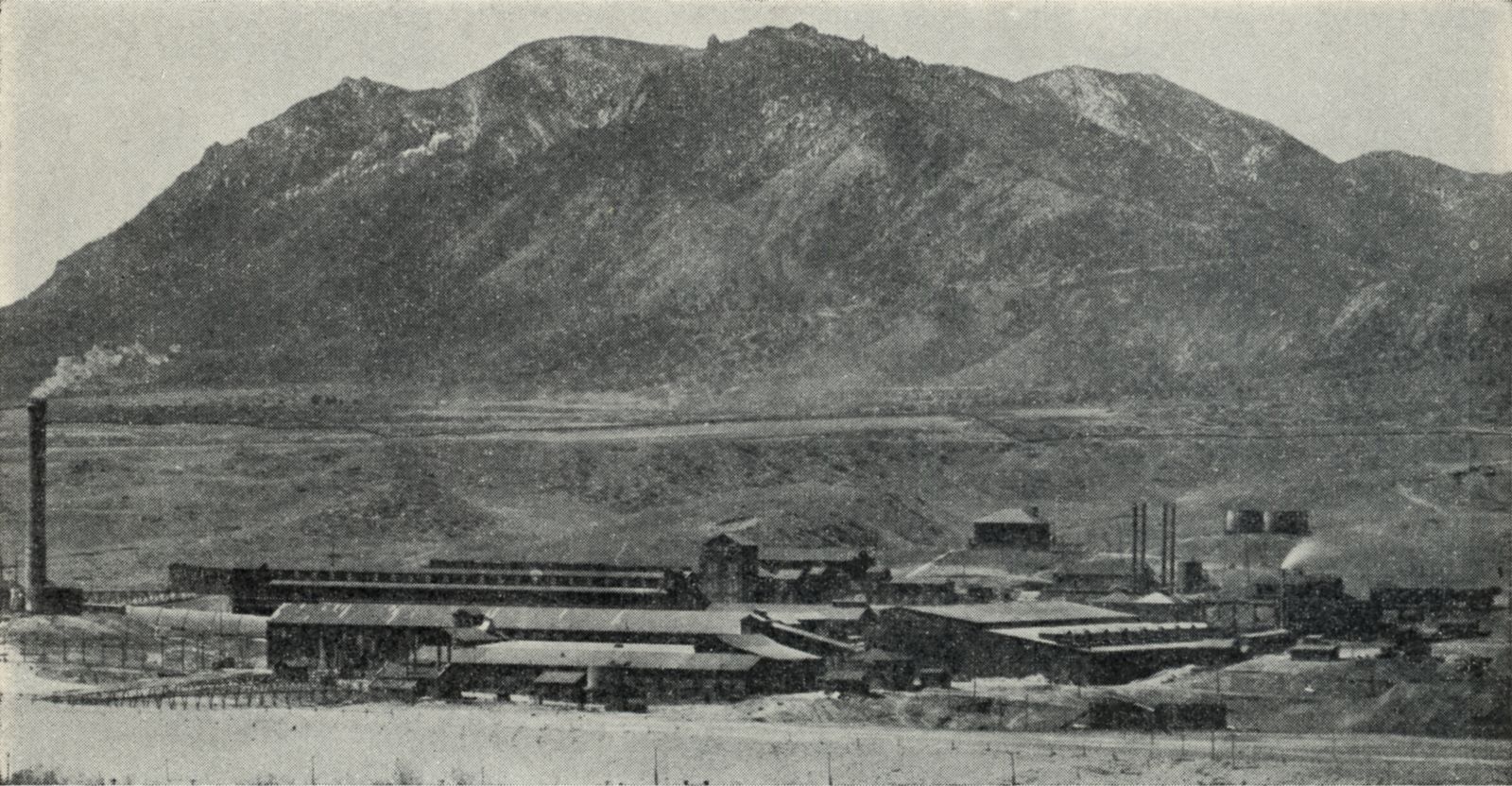
GOLDEN CYCLE MILL located at Colorado Springs. This is the largest Custom Gold Mill in operation today.
Colorado Springs, Colorado,
March 1, 1942.
MR. MERRILL E. SHOUP, President,
The Golden Cycle Corporation,
Colorado Springs, Colorado.
Dear Sir: The following report covers 1941 operations at the Golden Cycle Mill.
| Dry Tons | Percent of Tonnage | Assay Val. Oz. PerTon | Average Value | Gross Value | Percent of Value | |
|---|---|---|---|---|---|---|
| Cripple Creek District | 484,702 | 91.1 | $ 9.57 | $ 4,640,419.99 | 87.1 | |
| Other Districts | 47,425 | 8.9 | 14.44 | 684,618.56 | 12.9 | |
| Total | 532,127 | 100.0 | 0.3038 | $ 10.01 | $ 5,325,038.55 | 100.0 |
1940 (for comparative purposes) |
||||||
| Cripple Creek District | 485,155 | 88.1 | $ 9.06 | $ 4,394,533.57 | 83.8 | |
| Other Districts | 65,366 | 11.9 | 13.01 | 850,289.04 | 16.2 | |
| Total | 550,521 | 100.0 | 0.2905 | $ 9.53 | $ 5,244,822.61 | 100.0 |
| Increase (Decrease) | (18,394) | 0.0133 | $ 0.48 | $ 80,215.94 | ||
No ore from outside the State of Colorado was accepted for treatment at this plant.
| Decrease in Tonnage | 18,394 Tons |
| Increase in Assay Head of Ore | 0.0133 oz. per Ton |
| Increase in Value of Ore | $ 0.48 per Ton |
| $ 80,215.94 Total |
The increase in value of the Cripple Creek ore (approximately $0.50 per ton) undoubtedly is accounted for by the fact that the Ajax Mine was enabled to mine higher grade ores on the lower levels after the Carlton Tunnel was completed to the point that it drained the Ajax Mine. This drainage occurred during April and May, 1941.
On October 20, 1941, a new treatment schedule was placed in effect which increased the payment for gold $0.86 per ounce. This increase in payment was given to the mines in the hope that it would stimulate the exploration and development of new ore bodies and at the same time help offset the increased costs of mining.
During the year of 1941 improvements were made principally in the concentration, secondary crushing, roasting and cyanidation departments. A new Akins classifier was added to concentration department. A Short Head Symons cone crusher was installed in secondary crushing department. New supported arches were installed on five of the roasters, which completed that part of roaster improvements. Also the method of heating the roasters was improved by installing two more fireboxes on each roaster, making a total of four per roaster; this improved both the metallurgical and mechanical efficiency of the roasters. The pulverizer installation was completed and a boiler installed adjacent to the pulverizers, which simplified our steam production and effected a saving of several thousand dollars per year. Four of the leaching tanks were enlarged from 900-ton capacity to approximately 1,350 tons capacity. At the same time, concrete floors were poured under these tanks, which will eliminate loss of values by seepage, and also simplify operation and cleanups. The remaining four leaching tanks will undergo same alteration as rapidly as possible; the new method of automatic filling and discharging of these enlarged sand tanks effects quite a saving in cost of operation. The plant is in excellent condition and no excessive repairs should be necessary during the coming year. A concrete water storage tank of 385,000-gallon capacity was completed during the year, which effected quite a saving by reducing the pumping of water to a minimum.
We hope to continue our improvement program as much as possible during the coming year, but, of course, this will depend largely upon the tonnage of ore received at the mill. In case of a large decrease it will be necessary to curtail the alteration work and go on an operation basis only, letting our improvement program wait until the end of the war emergency.
The co-operation of Mr. Dycus, Mill Superintendent, the heads of various departments, foremen and all employees has been ideal and this co-operation has been a major factor in the successful year's operation during 1941.
Likewise the co-operation and support of yourself and the Board of Directors, of Mr. Bebee and the various operators in the Cripple Creek District, together with that of the Midland Terminal Railroad has helped in a large part to make the past a very successful year. For this support and co-operation, I again wish to express my personal appreciation together with that of our entire operating force.
Respectfully submitted,
MAX W. BOWEN.
Colorado Springs, Colorado,
March 1, 1942.
MR. MERRILL E. SHOUP, President,
The Golden Cycle Corporation,
Colorado Springs, Colorado.
Dear Sir: In spite of adverse economic conditions existing in the gold mining industry, the Cripple Creek District shipped to the Golden Cycle Mill 484,702 tons with a gross value of $4,640,419.99 and an average value of $9.57 per ton. This compares with 485,155 tons with a gross value of $4,394,533.57 and an average value of $9.06 per ton for 1940. This increase in value was partly due to ore coming from the lower levels of the Ajax Shaft of the Golden Cycle Corporation, which was completely drained by the Carlton Tunnel in February, 1941. All the lower levels of the Ajax were under water during the year 1940.
As in previous years, the United Gold Mines Company and the Cresson Consolidated Gold Mining and Milling Company were the largest shippers to the Mill, with the Golden Cycle Corporation, Mining Operations, third. These three companies accounted for 66 per cent of the ore. Lessees working on all properties in the District accounted for 83 per cent of all the ore shipped from the Cripple Creek District, and all properties are dependent upon the lessees for the greater part of their tonnage.
The Carlton Tunnel was finished to the breccia granite contact under the Portland in September, 1941. 6,293 feet of tunnel was driven in 1941. From July 18, 1939, to September 1, 1941, a total of 32,927 feet or 6.236 miles of tunnel was driven. The daily average was 46.9 feet. The last 4,000 feet of tunnel were driven under extremely difficult conditions, due to the heavy flows of water encountered. The first water cut in the tunnel was on February 18, 1941, when the New Market Fault in Ajax was reached. The flow of water at this time amounted to 25,000 gallons per minute. Work in the tunnel was suspended for about ten days until the water subsided to about 10,000 gallons per minute. It was then necessary to drop back about 200 feet from the face and change the course of the tunnel, in order to cut the fault in a different place. It was necessary to timber about 150 feet of heavy ground through the fault. From this point on, the tunnel was driven to the Portland without any great difficulty except heavy flows of water.

TERMINUS of the Carlton Drainage Tunnel under Portland No. 2 Shaft. Other famous producers on Battle Mountain, Cripple Creek Mining District.
It was expected, when the breccia granite contact was reached, that enough water would be cut to quickly drain the Portland Mine workings. 800 feet of water stood in the Portland Shaft at this time. Due to the tight ground only a small flow of water was opened, which did not give rapid enough drainage. It was then necessary to drive a 125-foot raise from the tunnel, and from the top of the raise run a short cross-cut toward the winze level of the Portland No. 2 Shaft and drain the Portland workings in this manner. When this water was released the tunnel flow increased to about 125,000 gallons per minute for a few hours, gradually subsiding to 6,000 gallons per minute. The heavy flow of water caused considerable damage in the tunnel, washing out track in several places and leaving considerable debris which was carried in from the Portland workings. This, however, has all been cleaned up and the tunnel is now in good shape.
All future expense of the tunnel, as far as the Golden Cycle Corporation is concerned, will be for maintenance and salvage work.
The United Gold Mines Company is now working in the tunnel, cutting a shaft station in preparation for connecting the shaft to the tunnel level. When this is completed, the United Gold Mines Company is planning to drive a lateral to the Vindicator Shaft, and the Cresson Consolidated Gold Mining and Milling Company will drive to the Cresson Shaft, in order to completely drain their properties.
The benefits of the tunnel to the mines of the Cripple Creek District, and to the Golden Cycle Mill in Colorado Springs, to date, are briefly these:
The AJAX SHAFT of the Golden Cycle Corporation has been completely drained, permitting development work and mining to be carried on in territory that was under water. Some very good ore has been shipped to the Mill the latter part of the year as a result of this work.
The PORTLAND No. 2 SHAFT has been drained and development work is now being done on the deeper levels of this property.
The CRESSON SHAFT has drained to a depth of 250 feet. Development work and mining of ore is now being carried on, on the 18th and 19th levels of this shaft.
The EL PASO MINE is also sinking a winze below the Roosevelt Tunnel.
Lessees and the dump, which the Company was washing and sorting, furnished all the production for the Ajax until the Carlton Tunnel drained the Mine in February, 1941. When the tunnel cut the New Market Fault, the Mine drained in ten days time. Clean up and repair work was started at once and within two months ore from the lower levels was being shipped to the Mill.
Production the latter part of the year was much greater than the first part and the Mine showed a profit instead of a loss. Company and lessees shipped 29,332 tons with a gross value of $437,760.05 and an average value of $14.92 per ton. This is above the average grade of ore shipped from the District and compares with 22,203 tons with a gross value of $226,628.07 and an average value of $10.21 per ton for the year 1940.
The following is a summary of the development work for 1941:
| Company | 3,154 | Feet |
| Lessees | 2,804 | Feet |
| Shaft Sinking | 194.5 | Feet |
| Total | 6,152.5 | Feet |
Development work opened ore on both the New Market and Bobtail vein systems on the 24th and 26th levels, and several drifts are now being driven on ore in different parts of the mine. Shaft sinking which is now in progress will open two new levels, the 27th and 28th. Cross-cutting and drifting for the various vein systems will start on these new levels as fast as conditions permit.
During the summer, the old frame boiler house, engine room, and machine shop were torn down and a fireproof cinder block and steel building, 40 x 105 feet, was erected to house the hoist, machine shop, warehouse and office. This eliminates another fire hazard on the property and saves considerably in fire insurance. The Ajax surface plant is now in much better shape than it has been in years.
During the first ten months of 1941, the Index was operated by the Company mainly for the accommodation of split check lessees. The Company, however, accomplished considerable development work and opened a number of small ore chutes, none of which were large enough to mine and make any money. It was decided to close the mine down on November 1, 1941, after the number of lessees dwindled to one set. A total of 1,662.5 feet of development work was done on the property during the year.
Development work on this property totaled 1,848 feet, of which the Company accomplished 720 feet and the lessees 1,128 feet. Production amounted to 9,228 tons with a gross value of $92,956.30 and an average value of $10.07 per ton. Operations showed a loss for the year after depletion of $4,224.71.
Development work is still continued on this property mainly by lessees, and it is hoped that sufficient ore will be opened to operate the mine at a profit.
Economic conditions due to the war are being very seriously felt in the Cripple Creek District today. Men leaving for the army, navy, and defense industries, which pay wages far above what we can pay, have caused a severe shortage of lessees throughout the District. These lessees, normally, all produce some ore, which very materially helps to make the Mill tonnage. At least 500 men have left this District in the past few months. The larger properties, such as the Cresson Consolidated Gold Mining and Milling Company, Ajax Operation, Portland Mine and Vindicator Mine, are now producing most of the ore shipped to the Mill, while in normal times a considerable tonnage is produced from many small operations operated by lessees scattered throughout the District.
Appreciation is expressed to Mr. J. S. Anderson, Superintendent of the Anchoria Leland Operation; Mr. Charles Carlton, Superintendent of the Ajax Operation; Mr. Robert Welch, Superintendent of the Carlton Tunnel, and all other employees for their loyalty, devotion and fine work.
Respectfully submitted,
A. H. BEBEE,
Vice President in Charge of Mining Operations.
Colorado Springs, Colorado,
March 1, 1942.
MR. MERRILL E. SHOUP, President,
The Midland Terminal Railway Company,
Colorado Springs, Colorado.
Dear Sir: The year 1941 was outstanding with respect to volume of revenue freight transported. However, commercial ballast shipments, comprising a substantial tonnage and commanding a relatively low freight rate, were considerably in excess of similar shipments in the preceding year; and notwithstanding the corresponding increase in total gross revenue, the lower margin of profit on this class of business contributed to a lower net profit per ton-mile for total freight handled.
Increased cost of many items of materials and supplies, particularly that of locomotive fuel, added acutely to operating expenses. An extraordinary expenditure of $35,691.70 was made during the year, covering cost of materials and labor to install approximately ten miles of second-hand, re-rolled 90-pound steel in main line tracks, the charges being apportioned under I. C. C. Accounting Classification as follows:
| Additions to Property | $ 9,585.48 |
| Operating Expenses | 26,106.22 |
The compilation below shows condensed results of operations in 1941, compared with the year 1940:
| 1941 | 1940 | |
|---|---|---|
| Ton-Miles—Revenue Freight | 30,668,525 | 29,875,149 |
| Gross Earnings | $ 570,627.29 | $ 556,400.93 |
| Expenses (including provision for taxes) | $ 493,491.45 | $ 432,806.12 |
| Depreciation | 20,984.64 | 12,157.42 |
| Net Earnings | $ 56,151.20 | $ 111,437.39 |
| Additions and Betterments | 21,017.63 | 22,335.08 |
| Remainder | $ 35,133.57 | $ 89,102.31 |

NEW POWER for the Cripple Creek ore haul. Midland ''62'', a recent addition to equipment of The Midland Terminal Railways, and now in regular service.
The two second-hand locomotives purchased in 1940 have been fully reconditioned. One unit was put into service in April, 1941, and has been giving excellent performance. The second unit made its initial trip on January 9, 1942, and also has been giving first class service.
| Additions: | |
| Reconditioning Two Locomotives | $ 8,933.13 |
| Rail Betterment | 9,585.48 |
| Track to New Gravel Pit | 1,842.52 |
| Coupe for Yardmaster | 656.50 |
| $ 21,017.63 | |
| Retirements: | |
| Track to Old Gravel Pit; M. P. 38 | $ 2,283.78 |
| Track to Old Gravel Pit; M. P. 25 | 1,759.48 |
| Retire Coach No. 21—worn out | 2,500.00 |
| Track to Rock Quarry—worked out | 585.65 |
| Track at Victor—not needed | 1,354.64 |
| Coupe—worn out | 561.00 |
| Oil Tanks at Colorado City—not needed | 308.41 |
| Yard Tracks—not needed | 82.87 |
| Flat Car—worn out | 200.00 |
| Yard Track—not needed | 618.04 |
| $ 10,253.87 | |
Physical condition of tracks has been substantially improved by relaying the rail mentioned above and also by special efforts in the renewal of ties, 23,619 first class, creosoted ties having been installed during the year. Other roadway properties, as well as locomotives and freight cars, have been kept in good, normal operating condition.
Very truly yours,
A. S. GILL, Vice President.
Main Line |
Spurs and Sidings |
Total Miles |
55.44 |
33.52 |
88.96 |
| Locomotives | 11 | |
| Passenger Train Cars : | ||
Coaches |
1 |
|
Baggage |
0 |
|
Combination |
4 |
|
5 |
||
| Track Motor Cars | 2 |
|
| Freight Train Cars : | ||
Box |
9 |
|
Coal |
162 |
|
Refrigerator |
11 |
|
Flat |
9 |
|
Stock |
5 |
|
Steel Dump |
55 |
|
Wood Dump |
0 |
|
Caboose |
2 |
|
| 253 | ||
| Company Service Cars : | ||
Business Car |
0 |
|
Motor Inspection Car |
1 |
|
Wrecking and Outfit |
4 |
|
Derrick |
1 |
|
Snow Plow |
1 |
|
Other Company Cars |
15 |
|
22 |
||
| Total Rolling Stock | 293 |
|
| Net Tons | Gross Value | Freight & Treatment | Net Returns to Company | Net Returns to Lessees | Av. Value Per Ton | Number Cars | |
|---|---|---|---|---|---|---|---|
| Company Ore | 15,359 | $ 251,203.86 | $ 86,980.83 | $ 164,223.03 | $ 16.36 | 481 | |
| Lessees' Ore | 13,973 | 186,556.19 | 66,677.01 | 58,124.87 | $ 61,754.31 | 13.35 | 418 |
| 29,332 | $ 437,760.05 | $ 153,657.84 | $ 222,347.90 | $ 61,754.31 | $ 14.92 | 899 | |
ORE PRODUCTION—AUGUST 23, 1935, TO DECEMBER 31, 1941 |
|||||||
| Net Tons | Gross Value | Freight & Treatment | Net Returns to Company | Net Returns to Lessees | Av. Value Per Ton | Number Cars | |
| Company Ore | 152,934 | $2,464,214.15 | $ 859,743.35 | $1,604,470.80 | $16.11 | 4,651 | |
| Lessees' Ore | 86,809 | 1,339,295.53 | 453,483.31 | 319,400.10 | $566,412.12 | 15.43 | 2,656 |
| 239,743 | $3,803,509.68 | $1,313,226.66 | $1,923,870.90 | $566,412.12 | $15.86 | 7,307 | |
| Net Tons | Gross Value | Freight & Treatment | Net Returns to Company | Net Returns to Lessees | Av. Value Per Ton | Number Cars | |
|---|---|---|---|---|---|---|---|
| Company Ore | 1,021 | $ 10,988.04 | $ 5,083.40 | $ 5,904.64 | $ 10.76 | 33 | |
| Lessees' Ore | 8,207 | 81,968.26 | 37,350.03 | 22,388.16 | $ 22,230.07 | 9.99 | 251 |
| 9,228 | $ 92,956.30 | $ 42,433.43 | $ 28,292.80 | $ 22,230.07 | $ 10.07 | 284 | |
ORE PRODUCTION—AUGUST, 1935, TO DECEMBER 31, 1941 |
|||||||
| Net Tons | Gross Value | Freight & Treatment | Net Returns to Company | Net Returns to Lessees | Av. Value Per Ton | Number Cars | |
| Company Ore | 15,145 | $ 267,380.73 | $ 93,366.86 | $ 174,013.87 | $17.65 | 466 | |
| Lessees' Ore | 31,159 | 308,741.79 | 145,142.93 | 81,904.62 | $ 81,694.24 | 9.91 | 985 |
| 46,304 | $ 576,122.52 | $ 238,509.79 | $ 255,918.49 | $ 81,694.24 | $ 12.44 | 1,451 | |
| Net Tons | Gross Value | Freight & Treatment | Net Returns to Company | Net Returns to Lessees | Av. Value Per Ton | Number Cars | |
|---|---|---|---|---|---|---|---|
| Company Ore | 370 | $ 1,762.26 | $ 1,292.67 | $ 469.59 | $ 4.76 | 12 | |
| Lessees' Ore | 3,866 | 35,148.09 | 16,830.40 | 9,100.90 | $ 9,216.79 | 9.09 | 119 |
| 4,236 | $ 36,910.35 | $ 18,123.07 | $ 9,570.49 | $ 9,216.79 | $ 8.71 | 131 | |
ORE PRODUCTION—JANUARY 1, 1940, TO DECEMBER 31, 1941 |
|||||||
| Net Tons | Gross Value | Freight & Treatment | Net Returns to Company | Net Returns to Lessees | Av. Value Per Ton | Number Cars | |
| Company Ore | 1,332 | $ 12,468.10 | $ 6,049.65 | $ 6,418.45 | $ 9.36 | 40 | |
| Lessees' Ore | 6,326 | 50,776.73 | 25,634.30 | 12,102.91 | $ 13,039.52 | 8.03 | 200 |
| 7,658 | $ 63,244.83 | $ 31,683.95 | $ 18,521.36 | $ 13,039.52 | $ 8.26 | 240 | |
| DECEMBER 31 | INCREASE | ||
|---|---|---|---|
| ASSETS | 1941 | 1940 | (DECREASE) |
| CURRENT ASSETS : | |||
| Cash | $ 904,446.01 | $ 1,177,005.59 | ($ 272,559.58) |
United States Government and other marketable securities (market value based principally upon published quotations - 1941, $338,000; 1940, $362,000) |
319,573.44 | 336,573.44 | (17,000.00) |
Note receivable |
13,508.00 | (13,508.00) | |
Accounts receivable—Trade (less reserve of $3,000, 1941 and 1940) |
117,911.84 | 107,632.01 | 10,279.83 |
Total cash, etc |
$ 1,341,931.29 | $ 1,634,719.04 | ($ 292,787.75) |
Inventories : |
|||
Bullion (valuation based upon proceeds from United States Mint) |
$ 69,930.84 | $ 59,838.04 | $ 10,092.80 |
Ore in process (estimated value based upon formula consistently used and current market) |
147,564.48 | 168,579.66 | (21,015.18) |
Merchandise (at cost which approximates market valuation) |
19,812.27 | 18,671.66 | 1,140.61 |
Operating and maintenance supplies (at less than market valuation) |
242,721.16 | 159,529.34 | 83,191.82 |
Total inventories |
$ 480,028.75 | $ 406,618.70 | $ 73,410.05 |
Total current assets |
$ 1,821,960.04 | $ 2.041,337.74 | ($ 219,377.70) |
| INVESTMENTS : | |||
United States Government and other marketable securities deposited to guarantee workmen's compensation insurance (quoted market values - 1941, $88,000; 1940, $90,000) |
$ 82,092.75 | $ 82,092.75 | |
Corporate stocks : |
|||
Controlled corporation (approximately 56% owned) |
37,244.83 | 37,019.83 | $ 225.00 |
Other corporations (quoted market values substantially in excess of book values) |
49,497.36 | 52,037.76 | (2,540.40) |
Total investments |
$ 168,834.94 | $ 171,150.34 | ($ 2,315.40) |
| FIXED ASSETS : | |||
Gold reduction mill, mine and other buildings, and machinery and equipment (less reserves for depreciation - 1941, $1,946,324.94; 1940, $1,868,312.80) |
$ 697,645.13 | $ 614,444.75 | $ 83,200.38 |
Carlton Drainage Tunnel—completed about March 1, 1941 (1941, less reserve of $101,034.43 for amortization) |
980,255.29 | 896,950.38 | 83,304.91 |
Railroad buildings, roadway, and transportation equipment (less reserves for depreciation - 1941, $2,612,258.66; 1940, $2,599,803.56) |
138,472.49 | 140,106.53 | (1,634.04) |
Coal lands, and ore deposits, including increase of $1,326,751.50 from appraisal of coal lands in 1917 (less reserves for depletion - 1941, $568,397.37; 1940, $545,278.93) |
1,048,989.70 | 1,060,768.79 | (11,779.09) |
Other real estate |
90,051.47 | 89,039.75 | 1,011.72 |
Fixed assets—net |
$ 2,955,414.08 | $ 2,801,310.20 | $ 154,103.88 |
| PREPAID EXPENSES, DEFERRED CHARGES, ETC | $ 54,346.50 | $ 66,086.26 | ($ 11,739.76) |
TOTAL |
$ 5,000,555.56 | $ 5,079,884.54 | ($ 79,328.98) |
| DECEMBER 31 | INCREASE | ||||
|---|---|---|---|---|---|
| LIABILITIES | 1941 | 1940 | (DECREASE) | ||
| CURRENT LIABILITIES : | |||||
Accounts payable—Trade |
$ 100,912.03 | $ 146,297.48 | ($ 45,385.45) | ||
Accrued liabilities : |
|||||
Salaries and wages |
40,481.92 | 45,492.95 | (5,011.03) | ||
Federal and Colorado income taxes |
236,479.14 | 219,280.50 | 17,198.64 | ||
Property and other taxes |
104,574.89 | 103,380.64 | 1,194.25 | ||
Other—Current portion of compensation awards, etc |
7,043.02 | 5,490.48 | 1,552.54 | ||
Total current liabilities |
$ 489,491.00 | $ 519,942.05 | ($ 30,451.05) | ||
| NON-CURRENT LIABILITIES—Principally workmen's compensation awards payable after one year from balance sheet date | $ 16,741.50 | $ 20,541.82 | ($ 3,800.32) | ||
| RESERVES : | |||||
Workmen's compensation—future awards (self-insured except for insurance coverage as to certain excess liabilities) |
$ 125,000.00 | $ 125,000.00 | |||
Contingencies |
89,166.45 | 89,166.45 | |||
Net excess of par value over cost of reacquired capital stock held in treasury |
66,424.86 | 66,444.00 | ($ 19.14) | ||
Total reserves |
$ 280,591.31 | $ 280,610.45 | ($ 19.14) | ||
| CAPITAL STOCK (authorized 300,000 shares of $10.00 each) : | |||||
| 1941 | 1940 | ||||
Issued |
259,647.00 shares | 259,647.00 shares | |||
Less in treasury |
72,593.84 shares | 72,593.18 shares | |||
Outstanding |
187,053.16 shares | 187,053.82 shares | $ 1,870,531.60 | $ 1,870,538.20 | ($ 6.60) |
| SURPLUS : | |||||
Paid-in surplus |
$ 273,131.27 | $ 273,131.27 | |||
Surplus arising from revaluation of coal lands in 1917 |
1,326,751.50 | 1,326,751.50 | |||
Other capital surplus |
690,636.86 | 690,636.86 | |||
Earned surplus |
52,680.52 | 97,732.39 | ($ 45,051.87) | ||
Total surplus |
$ 2,343,200.15 | $ 2,388,252.02 | ($ 45,051.87) | ||
TOTAL |
$ 5,000,555.56 | $ 5,079,884.54 | ($ 79,328.98) | ||
| DECEMBER 31 | INCREASE | ||
|---|---|---|---|
| 1941 | 1940 | (DECREASE) | |
| Sales of precious metals, and of coal and other commodities, and operating revenues of railway and stage companies | $ 6,233,401.21 | $ 6,079,798.21 | $ 153,603.00 |
| Cost of sales, and operating expenses of railway and stage companies (including tunnel amortization and excluding taxes shown separately) | 5,344,846.91 | 5,067,957.79 | 276,889.12 |
| Gross profit from sales, and operating profits of railway and stage companies (before taxes shown separately) | $ 888,554.30 | $ 1,011,840.42 | ($ 123,286.12) |
| Selling, general and administrative expenses, etc. : | |||
Selling and delivery expenses |
$ 87,490.97 | $ 98,392.24 | ($ 10,901.27) |
General and administrative expenses |
91,861.78 | 105,105.27 | (13,243.49) |
Taxes (other than income taxes) |
142,944.75 | 119,196.92 | 23,747.83 |
Total |
$ 322,297.50 | $ 322,694.43 | ($ 396.93) |
| Profit from operations | $ 566,256.80 | $ 689,145.99 | ($ 122,889.19) |
| Other income : | |||
Interest on United States Government and other securities |
$ 15,254.47 | $ 12,466.05 | $ 2,788.42 |
Dividends |
7,878.36 | 2,535.00 | 5,343.36 |
Royalties, rents, etc. (net) |
139,723.23 | 94,462.02 | 45,261.21 |
Total |
$ 162,856.06 | $ 109,463.07 | $ 53,392.99 |
| Gross income | $ 729,112.86 | $ 798,609.06 | ($ 69,496.20) |
| Income deductions : | |||
Interest |
$ 8,259.82 | $ 213.04 | $ 8.046.78 |
Other |
1,508.39 | 1,756.16 | (247.77) |
Total |
$ 9,768.21 | $ 1.969.20 | $ 7,799.01 |
| Net income before provision for taxes on income | $ 719,344.65 | $ 796,639.86 | ($ 77,295.21) |
| Provision for taxes on income : | |||
Federal |
$ 230,000.00 | $ 188.000.00 | $ 42,000.00 |
Colorado |
20,000.00 | 24,000.00 | (4,000.00) |
Total |
$ 250,000.00 | $ 212,000.00 | $ 38,000.00 |
| Net income | $ 469,344.65 | $ 584,639.86 | ($115,295.21) |
| Earned surplus (deficit) at beginning of the year | 97,732.39 | (19,273.42) | 117,005.81 |
Total |
$ 567,077.04 | $ 565,366.44 | $ 1.710.60 |
| Dividends (quarterly payments aggregating $2.75 per share in 1941 and $2.50 per share in 1940) | 514,396.52 | 467,634.05 | 46,762.47 |
| Earned surplus at end of the year | $ 52,680.52 | $ 97.732.39 | ($ 45,051.87) |
Provisional charges to operations for depreciation, depletion, and amortization were as follows : |
1941 | 1940 | |
Depreciation |
$ 102,259.40 | $ 87,451.77 | |
Depletion |
23,118.44 | 20,918.55 | |
Amortization of cost of Carlton Drainage Tunnel (ten months ended December 31, 1941) |
101,034.43 | ||
Total |
$ 226,412.27 | $ 108,370.32 | |
We have examined the consolidated balance sheet of The Golden Cycle Corporation and its wholly owned subisdiaries, The Midland Terminal Railway Company and Cripple Creek-Victor and Colorado Springs Stage Company, as of December 31, 1941, and the related summary of consolidated income and earned surplus for the year ended that date, have reviewed the accounting procedures of the companies, and have examined their accounting records and other evidence in support of such financial statements. Our examination was made in accordance with generally accepted auditing standards applicable in the circumstances and included all auditing procedures we considered necessary, which procedures were applied by tests to the extent we deemed appropriate in view of the systems of internal control, except that our examination of the inventories did not include physical tests of quantities because the nature of the principal product precluded effective-physical tests by us.
In our opinion, subject to the exception stated above with respect to the scope of our examination of inventories, the accompanying consolidated balance sheet and related summary of consolidated income and earned surplus fairly present the financial condition of the companies at December 31, 1941, and the results of their operations for the year ended that date, in conformity with generally accepted accounting principles and practices applied on a basis consistent with that of the preceding year.
Denver, ColoradoMarch 1, 1942.
HASKINS & SELLS
